Public Health Report: CBT Intervention for Youth Mental Health Issues
VerifiedAdded on 2023/01/10
|13
|4947
|47
Report
AI Summary
This report delves into a public health intervention focused on addressing mental health issues in young people, particularly in the United Kingdom, where depression and anxiety are prevalent concerns. The intervention of choice is Cognitive Behavioral Therapy (CBT). The report begins by discussing the core concepts and principles of modern public health, emphasizing its interdisciplinary nature and the importance of mental wellbeing. It then explores the key elements of the CBT intervention, including how it is evaluated, and reviews the supporting evidence to determine its effectiveness. The report also examines a past evaluation of the intervention and offers recommendations for improvements. The overall aim is to provide a thorough analysis of CBT as a viable public health strategy for improving the mental health of young individuals, highlighting its principles, implementation, and evaluation within the context of public health practice.
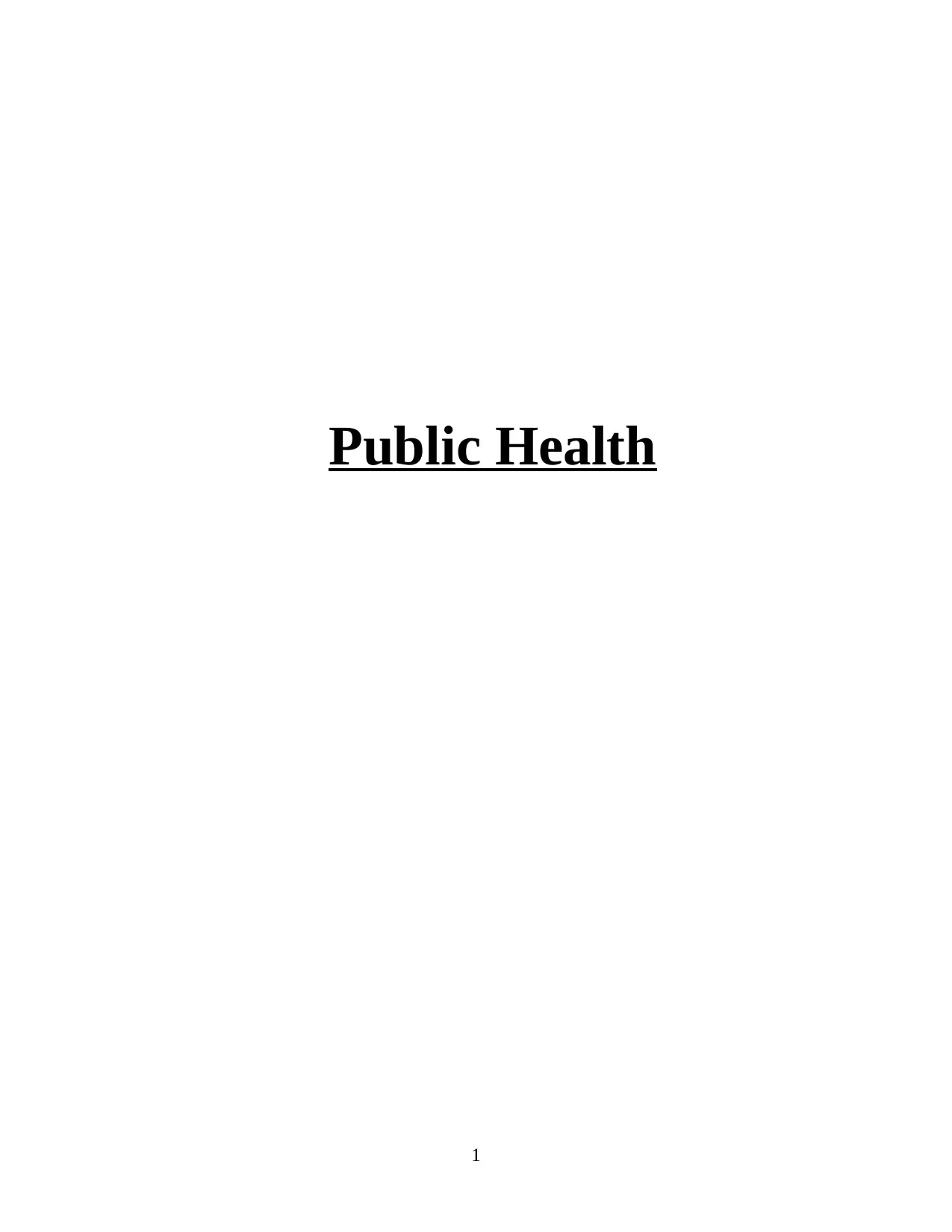
Public Health
1
1
Paraphrase This Document
Need a fresh take? Get an instant paraphrase of this document with our AI Paraphraser
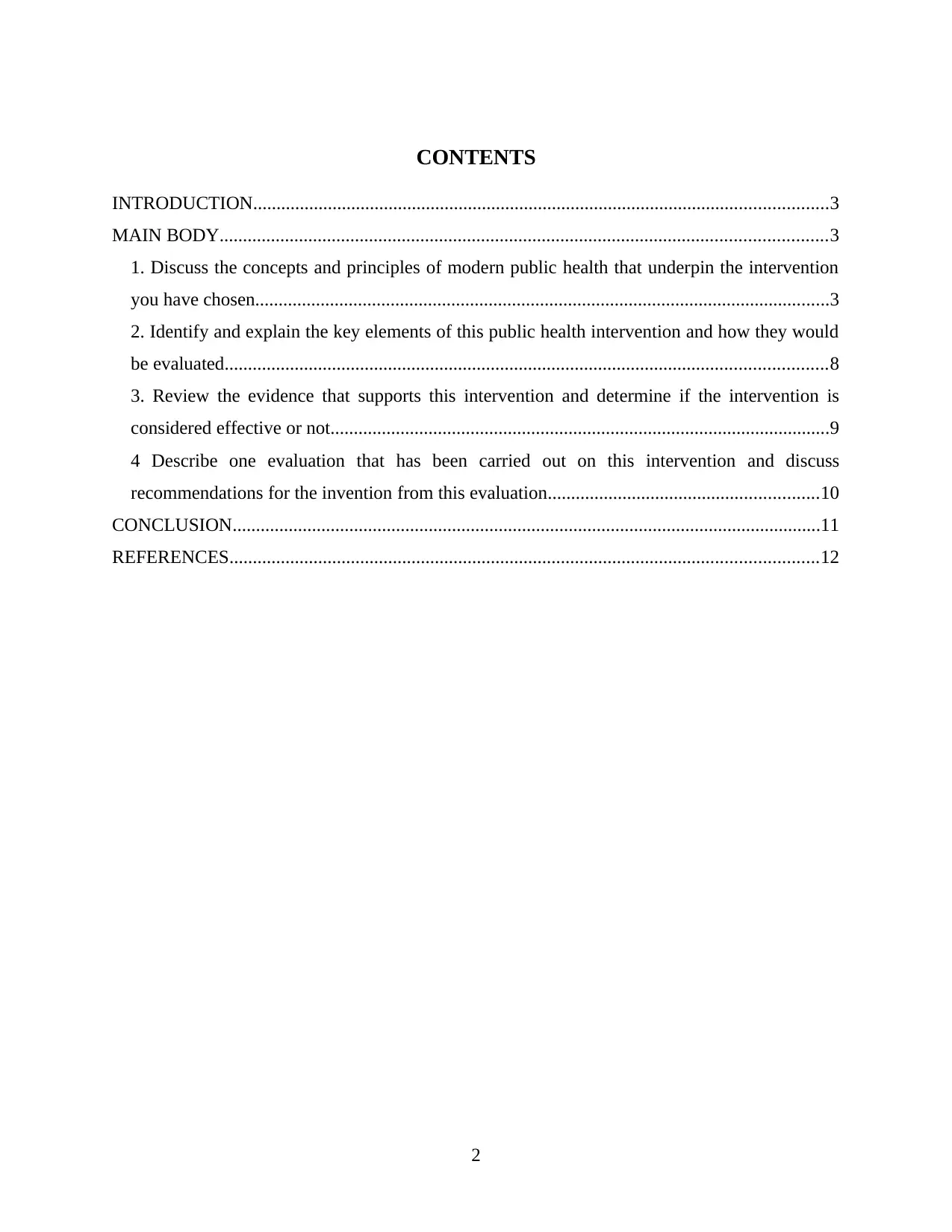
CONTENTS
INTRODUCTION...........................................................................................................................3
MAIN BODY..................................................................................................................................3
1. Discuss the concepts and principles of modern public health that underpin the intervention
you have chosen...........................................................................................................................3
2. Identify and explain the key elements of this public health intervention and how they would
be evaluated.................................................................................................................................8
3. Review the evidence that supports this intervention and determine if the intervention is
considered effective or not...........................................................................................................9
4 Describe one evaluation that has been carried out on this intervention and discuss
recommendations for the invention from this evaluation..........................................................10
CONCLUSION..............................................................................................................................11
REFERENCES..............................................................................................................................12
2
INTRODUCTION...........................................................................................................................3
MAIN BODY..................................................................................................................................3
1. Discuss the concepts and principles of modern public health that underpin the intervention
you have chosen...........................................................................................................................3
2. Identify and explain the key elements of this public health intervention and how they would
be evaluated.................................................................................................................................8
3. Review the evidence that supports this intervention and determine if the intervention is
considered effective or not...........................................................................................................9
4 Describe one evaluation that has been carried out on this intervention and discuss
recommendations for the invention from this evaluation..........................................................10
CONCLUSION..............................................................................................................................11
REFERENCES..............................................................................................................................12
2
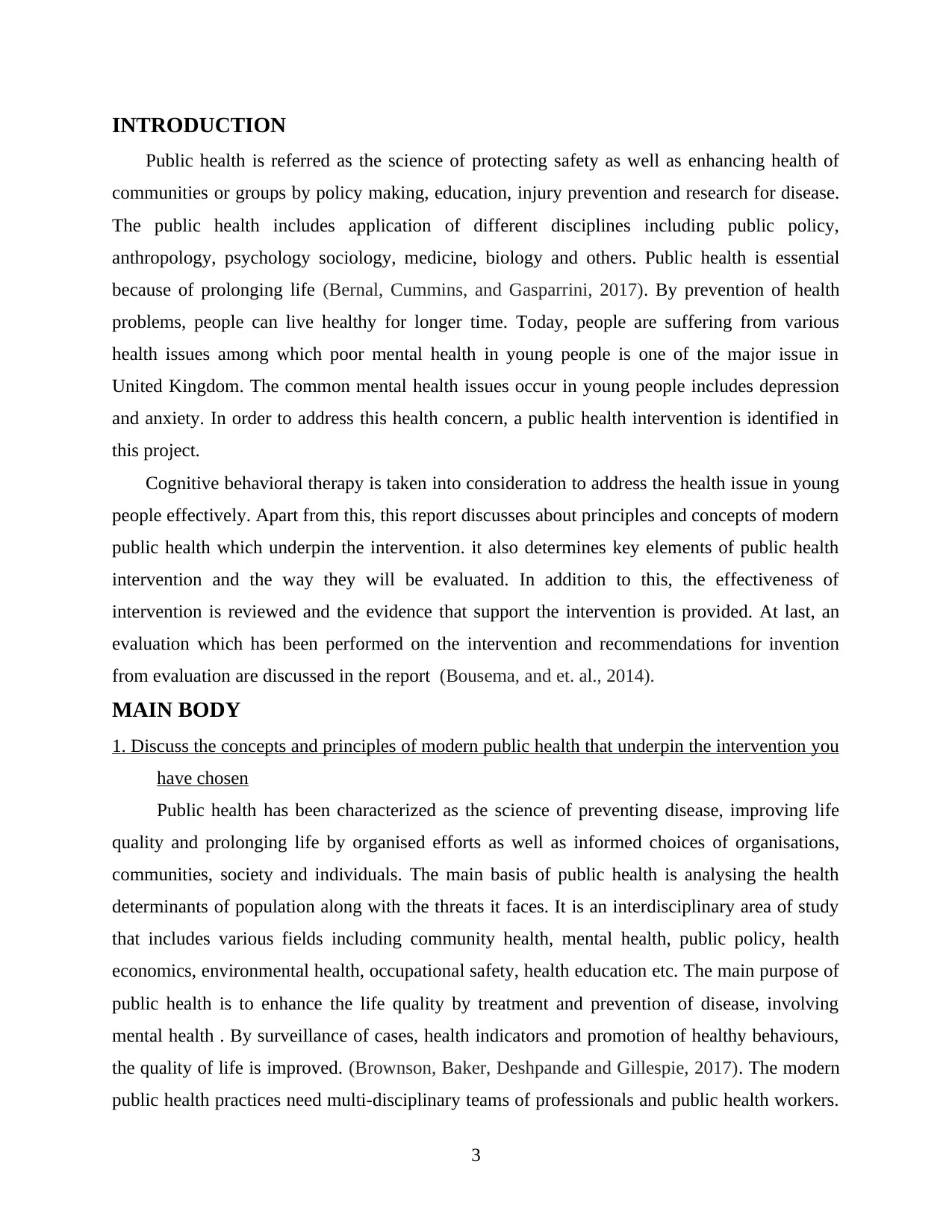
INTRODUCTION
Public health is referred as the science of protecting safety as well as enhancing health of
communities or groups by policy making, education, injury prevention and research for disease.
The public health includes application of different disciplines including public policy,
anthropology, psychology sociology, medicine, biology and others. Public health is essential
because of prolonging life (Bernal, Cummins, and Gasparrini, 2017). By prevention of health
problems, people can live healthy for longer time. Today, people are suffering from various
health issues among which poor mental health in young people is one of the major issue in
United Kingdom. The common mental health issues occur in young people includes depression
and anxiety. In order to address this health concern, a public health intervention is identified in
this project.
Cognitive behavioral therapy is taken into consideration to address the health issue in young
people effectively. Apart from this, this report discusses about principles and concepts of modern
public health which underpin the intervention. it also determines key elements of public health
intervention and the way they will be evaluated. In addition to this, the effectiveness of
intervention is reviewed and the evidence that support the intervention is provided. At last, an
evaluation which has been performed on the intervention and recommendations for invention
from evaluation are discussed in the report (Bousema, and et. al., 2014).
MAIN BODY
1. Discuss the concepts and principles of modern public health that underpin the intervention you
have chosen
Public health has been characterized as the science of preventing disease, improving life
quality and prolonging life by organised efforts as well as informed choices of organisations,
communities, society and individuals. The main basis of public health is analysing the health
determinants of population along with the threats it faces. It is an interdisciplinary area of study
that includes various fields including community health, mental health, public policy, health
economics, environmental health, occupational safety, health education etc. The main purpose of
public health is to enhance the life quality by treatment and prevention of disease, involving
mental health . By surveillance of cases, health indicators and promotion of healthy behaviours,
the quality of life is improved. (Brownson, Baker, Deshpande and Gillespie, 2017). The modern
public health practices need multi-disciplinary teams of professionals and public health workers.
3
Public health is referred as the science of protecting safety as well as enhancing health of
communities or groups by policy making, education, injury prevention and research for disease.
The public health includes application of different disciplines including public policy,
anthropology, psychology sociology, medicine, biology and others. Public health is essential
because of prolonging life (Bernal, Cummins, and Gasparrini, 2017). By prevention of health
problems, people can live healthy for longer time. Today, people are suffering from various
health issues among which poor mental health in young people is one of the major issue in
United Kingdom. The common mental health issues occur in young people includes depression
and anxiety. In order to address this health concern, a public health intervention is identified in
this project.
Cognitive behavioral therapy is taken into consideration to address the health issue in young
people effectively. Apart from this, this report discusses about principles and concepts of modern
public health which underpin the intervention. it also determines key elements of public health
intervention and the way they will be evaluated. In addition to this, the effectiveness of
intervention is reviewed and the evidence that support the intervention is provided. At last, an
evaluation which has been performed on the intervention and recommendations for invention
from evaluation are discussed in the report (Bousema, and et. al., 2014).
MAIN BODY
1. Discuss the concepts and principles of modern public health that underpin the intervention you
have chosen
Public health has been characterized as the science of preventing disease, improving life
quality and prolonging life by organised efforts as well as informed choices of organisations,
communities, society and individuals. The main basis of public health is analysing the health
determinants of population along with the threats it faces. It is an interdisciplinary area of study
that includes various fields including community health, mental health, public policy, health
economics, environmental health, occupational safety, health education etc. The main purpose of
public health is to enhance the life quality by treatment and prevention of disease, involving
mental health . By surveillance of cases, health indicators and promotion of healthy behaviours,
the quality of life is improved. (Brownson, Baker, Deshpande and Gillespie, 2017). The modern
public health practices need multi-disciplinary teams of professionals and public health workers.
3
⊘ This is a preview!⊘
Do you want full access?
Subscribe today to unlock all pages.

Trusted by 1+ million students worldwide
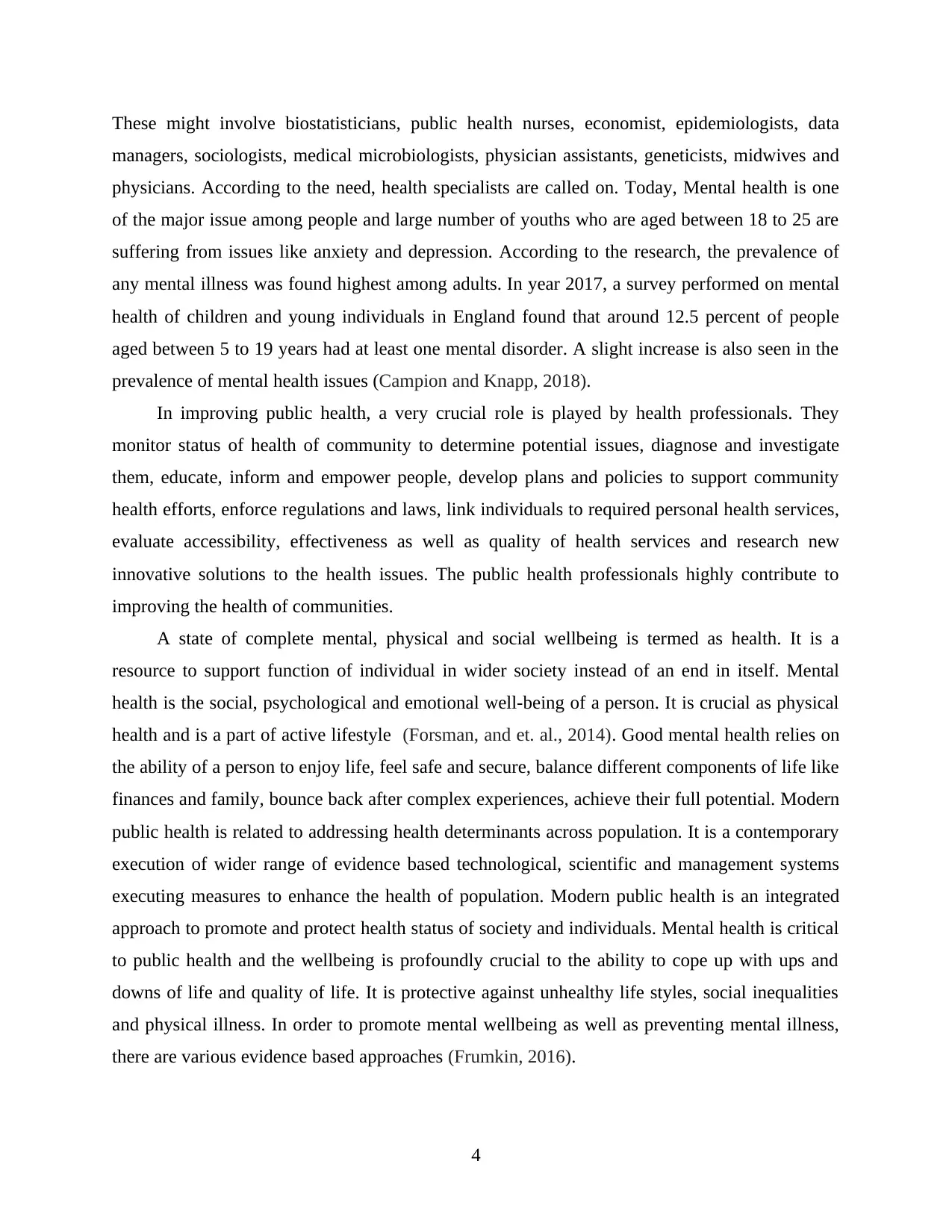
These might involve biostatisticians, public health nurses, economist, epidemiologists, data
managers, sociologists, medical microbiologists, physician assistants, geneticists, midwives and
physicians. According to the need, health specialists are called on. Today, Mental health is one
of the major issue among people and large number of youths who are aged between 18 to 25 are
suffering from issues like anxiety and depression. According to the research, the prevalence of
any mental illness was found highest among adults. In year 2017, a survey performed on mental
health of children and young individuals in England found that around 12.5 percent of people
aged between 5 to 19 years had at least one mental disorder. A slight increase is also seen in the
prevalence of mental health issues (Campion and Knapp, 2018).
In improving public health, a very crucial role is played by health professionals. They
monitor status of health of community to determine potential issues, diagnose and investigate
them, educate, inform and empower people, develop plans and policies to support community
health efforts, enforce regulations and laws, link individuals to required personal health services,
evaluate accessibility, effectiveness as well as quality of health services and research new
innovative solutions to the health issues. The public health professionals highly contribute to
improving the health of communities.
A state of complete mental, physical and social wellbeing is termed as health. It is a
resource to support function of individual in wider society instead of an end in itself. Mental
health is the social, psychological and emotional well-being of a person. It is crucial as physical
health and is a part of active lifestyle (Forsman, and et. al., 2014). Good mental health relies on
the ability of a person to enjoy life, feel safe and secure, balance different components of life like
finances and family, bounce back after complex experiences, achieve their full potential. Modern
public health is related to addressing health determinants across population. It is a contemporary
execution of wider range of evidence based technological, scientific and management systems
executing measures to enhance the health of population. Modern public health is an integrated
approach to promote and protect health status of society and individuals. Mental health is critical
to public health and the wellbeing is profoundly crucial to the ability to cope up with ups and
downs of life and quality of life. It is protective against unhealthy life styles, social inequalities
and physical illness. In order to promote mental wellbeing as well as preventing mental illness,
there are various evidence based approaches (Frumkin, 2016).
4
managers, sociologists, medical microbiologists, physician assistants, geneticists, midwives and
physicians. According to the need, health specialists are called on. Today, Mental health is one
of the major issue among people and large number of youths who are aged between 18 to 25 are
suffering from issues like anxiety and depression. According to the research, the prevalence of
any mental illness was found highest among adults. In year 2017, a survey performed on mental
health of children and young individuals in England found that around 12.5 percent of people
aged between 5 to 19 years had at least one mental disorder. A slight increase is also seen in the
prevalence of mental health issues (Campion and Knapp, 2018).
In improving public health, a very crucial role is played by health professionals. They
monitor status of health of community to determine potential issues, diagnose and investigate
them, educate, inform and empower people, develop plans and policies to support community
health efforts, enforce regulations and laws, link individuals to required personal health services,
evaluate accessibility, effectiveness as well as quality of health services and research new
innovative solutions to the health issues. The public health professionals highly contribute to
improving the health of communities.
A state of complete mental, physical and social wellbeing is termed as health. It is a
resource to support function of individual in wider society instead of an end in itself. Mental
health is the social, psychological and emotional well-being of a person. It is crucial as physical
health and is a part of active lifestyle (Forsman, and et. al., 2014). Good mental health relies on
the ability of a person to enjoy life, feel safe and secure, balance different components of life like
finances and family, bounce back after complex experiences, achieve their full potential. Modern
public health is related to addressing health determinants across population. It is a contemporary
execution of wider range of evidence based technological, scientific and management systems
executing measures to enhance the health of population. Modern public health is an integrated
approach to promote and protect health status of society and individuals. Mental health is critical
to public health and the wellbeing is profoundly crucial to the ability to cope up with ups and
downs of life and quality of life. It is protective against unhealthy life styles, social inequalities
and physical illness. In order to promote mental wellbeing as well as preventing mental illness,
there are various evidence based approaches (Frumkin, 2016).
4
Paraphrase This Document
Need a fresh take? Get an instant paraphrase of this document with our AI Paraphraser
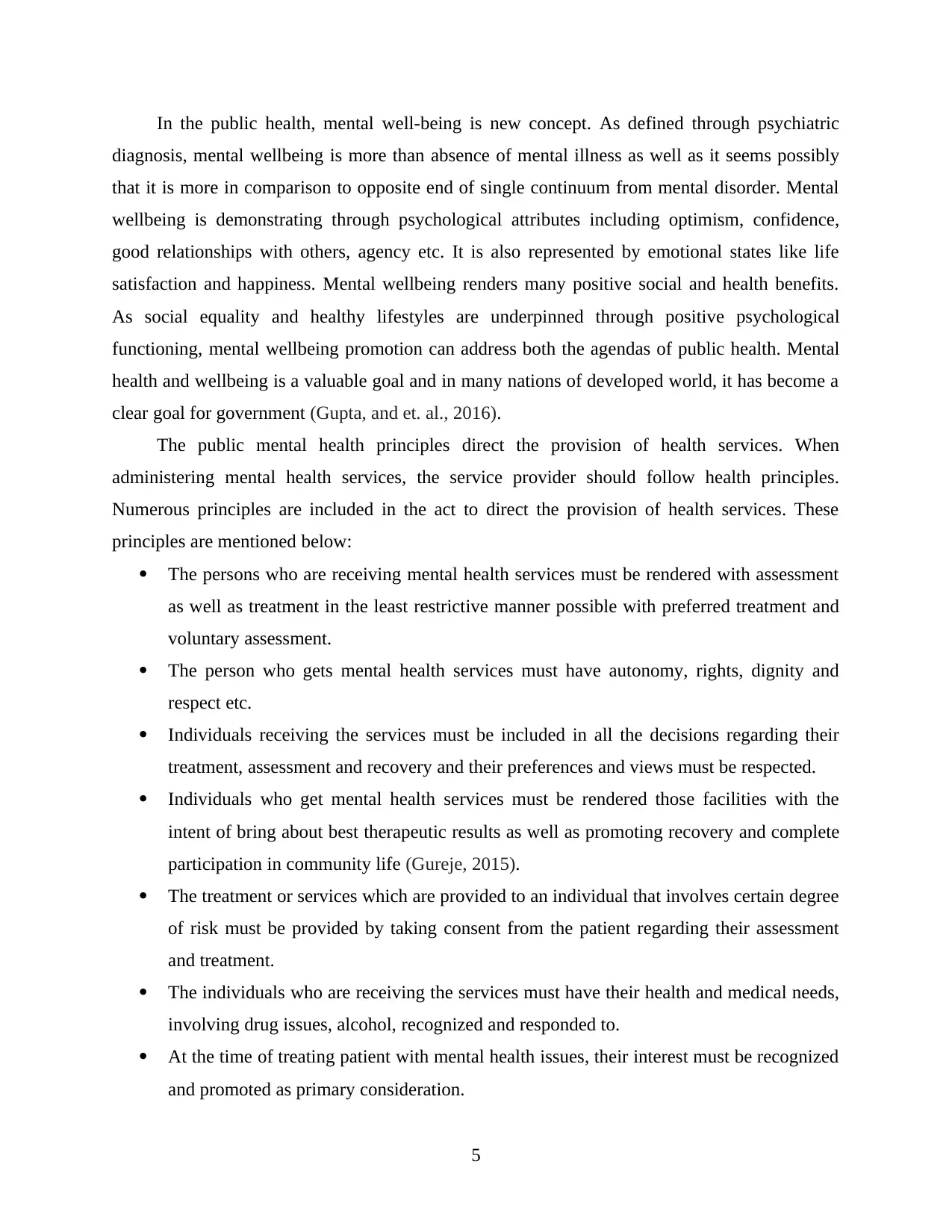
In the public health, mental well-being is new concept. As defined through psychiatric
diagnosis, mental wellbeing is more than absence of mental illness as well as it seems possibly
that it is more in comparison to opposite end of single continuum from mental disorder. Mental
wellbeing is demonstrating through psychological attributes including optimism, confidence,
good relationships with others, agency etc. It is also represented by emotional states like life
satisfaction and happiness. Mental wellbeing renders many positive social and health benefits.
As social equality and healthy lifestyles are underpinned through positive psychological
functioning, mental wellbeing promotion can address both the agendas of public health. Mental
health and wellbeing is a valuable goal and in many nations of developed world, it has become a
clear goal for government (Gupta, and et. al., 2016).
The public mental health principles direct the provision of health services. When
administering mental health services, the service provider should follow health principles.
Numerous principles are included in the act to direct the provision of health services. These
principles are mentioned below:
The persons who are receiving mental health services must be rendered with assessment
as well as treatment in the least restrictive manner possible with preferred treatment and
voluntary assessment.
The person who gets mental health services must have autonomy, rights, dignity and
respect etc.
Individuals receiving the services must be included in all the decisions regarding their
treatment, assessment and recovery and their preferences and views must be respected.
Individuals who get mental health services must be rendered those facilities with the
intent of bring about best therapeutic results as well as promoting recovery and complete
participation in community life (Gureje, 2015).
The treatment or services which are provided to an individual that involves certain degree
of risk must be provided by taking consent from the patient regarding their assessment
and treatment.
The individuals who are receiving the services must have their health and medical needs,
involving drug issues, alcohol, recognized and responded to.
At the time of treating patient with mental health issues, their interest must be recognized
and promoted as primary consideration.
5
diagnosis, mental wellbeing is more than absence of mental illness as well as it seems possibly
that it is more in comparison to opposite end of single continuum from mental disorder. Mental
wellbeing is demonstrating through psychological attributes including optimism, confidence,
good relationships with others, agency etc. It is also represented by emotional states like life
satisfaction and happiness. Mental wellbeing renders many positive social and health benefits.
As social equality and healthy lifestyles are underpinned through positive psychological
functioning, mental wellbeing promotion can address both the agendas of public health. Mental
health and wellbeing is a valuable goal and in many nations of developed world, it has become a
clear goal for government (Gupta, and et. al., 2016).
The public mental health principles direct the provision of health services. When
administering mental health services, the service provider should follow health principles.
Numerous principles are included in the act to direct the provision of health services. These
principles are mentioned below:
The persons who are receiving mental health services must be rendered with assessment
as well as treatment in the least restrictive manner possible with preferred treatment and
voluntary assessment.
The person who gets mental health services must have autonomy, rights, dignity and
respect etc.
Individuals receiving the services must be included in all the decisions regarding their
treatment, assessment and recovery and their preferences and views must be respected.
Individuals who get mental health services must be rendered those facilities with the
intent of bring about best therapeutic results as well as promoting recovery and complete
participation in community life (Gureje, 2015).
The treatment or services which are provided to an individual that involves certain degree
of risk must be provided by taking consent from the patient regarding their assessment
and treatment.
The individuals who are receiving the services must have their health and medical needs,
involving drug issues, alcohol, recognized and responded to.
At the time of treating patient with mental health issues, their interest must be recognized
and promoted as primary consideration.
5
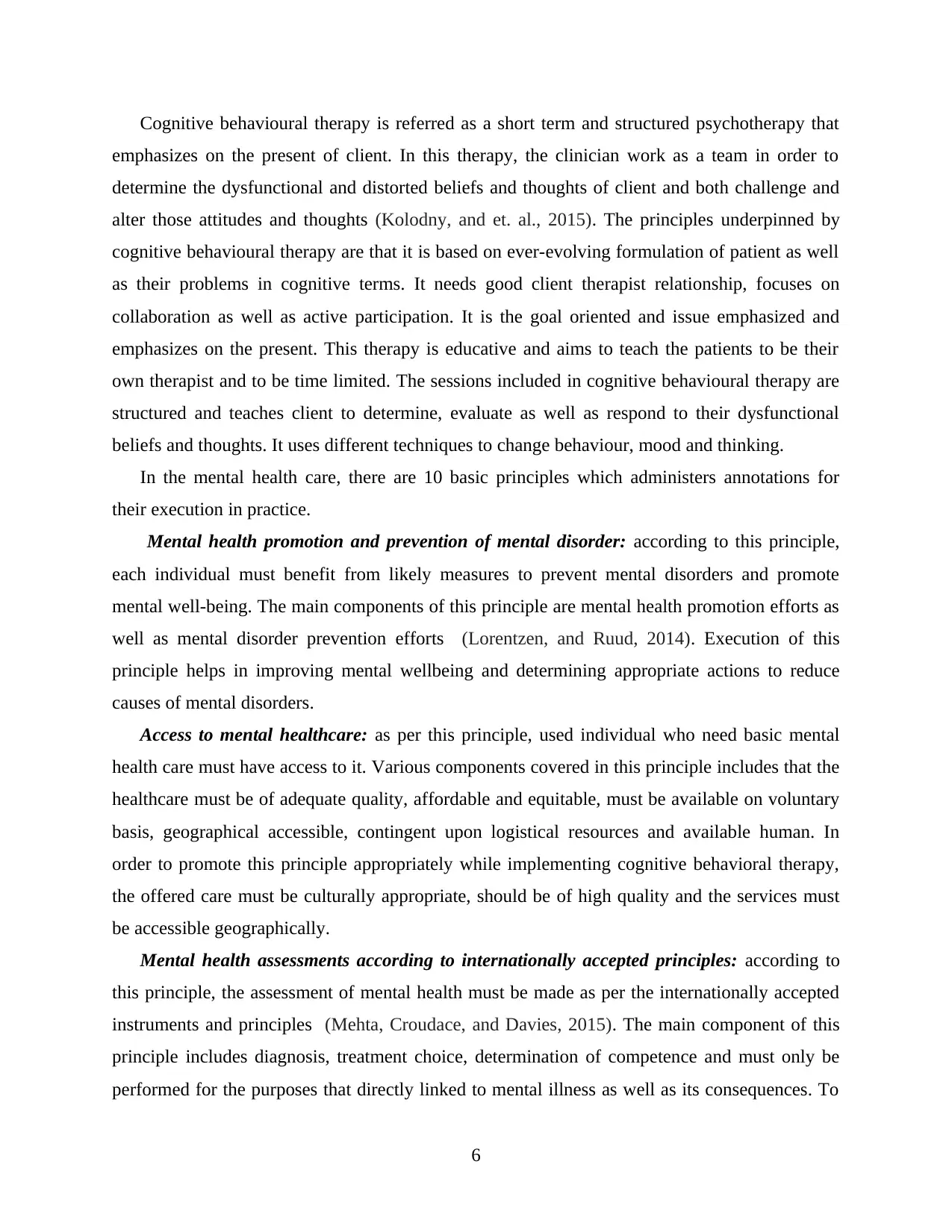
Cognitive behavioural therapy is referred as a short term and structured psychotherapy that
emphasizes on the present of client. In this therapy, the clinician work as a team in order to
determine the dysfunctional and distorted beliefs and thoughts of client and both challenge and
alter those attitudes and thoughts (Kolodny, and et. al., 2015). The principles underpinned by
cognitive behavioural therapy are that it is based on ever-evolving formulation of patient as well
as their problems in cognitive terms. It needs good client therapist relationship, focuses on
collaboration as well as active participation. It is the goal oriented and issue emphasized and
emphasizes on the present. This therapy is educative and aims to teach the patients to be their
own therapist and to be time limited. The sessions included in cognitive behavioural therapy are
structured and teaches client to determine, evaluate as well as respond to their dysfunctional
beliefs and thoughts. It uses different techniques to change behaviour, mood and thinking.
In the mental health care, there are 10 basic principles which administers annotations for
their execution in practice.
Mental health promotion and prevention of mental disorder: according to this principle,
each individual must benefit from likely measures to prevent mental disorders and promote
mental well-being. The main components of this principle are mental health promotion efforts as
well as mental disorder prevention efforts (Lorentzen, and Ruud, 2014). Execution of this
principle helps in improving mental wellbeing and determining appropriate actions to reduce
causes of mental disorders.
Access to mental healthcare: as per this principle, used individual who need basic mental
health care must have access to it. Various components covered in this principle includes that the
healthcare must be of adequate quality, affordable and equitable, must be available on voluntary
basis, geographical accessible, contingent upon logistical resources and available human. In
order to promote this principle appropriately while implementing cognitive behavioral therapy,
the offered care must be culturally appropriate, should be of high quality and the services must
be accessible geographically.
Mental health assessments according to internationally accepted principles: according to
this principle, the assessment of mental health must be made as per the internationally accepted
instruments and principles (Mehta, Croudace, and Davies, 2015). The main component of this
principle includes diagnosis, treatment choice, determination of competence and must only be
performed for the purposes that directly linked to mental illness as well as its consequences. To
6
emphasizes on the present of client. In this therapy, the clinician work as a team in order to
determine the dysfunctional and distorted beliefs and thoughts of client and both challenge and
alter those attitudes and thoughts (Kolodny, and et. al., 2015). The principles underpinned by
cognitive behavioural therapy are that it is based on ever-evolving formulation of patient as well
as their problems in cognitive terms. It needs good client therapist relationship, focuses on
collaboration as well as active participation. It is the goal oriented and issue emphasized and
emphasizes on the present. This therapy is educative and aims to teach the patients to be their
own therapist and to be time limited. The sessions included in cognitive behavioural therapy are
structured and teaches client to determine, evaluate as well as respond to their dysfunctional
beliefs and thoughts. It uses different techniques to change behaviour, mood and thinking.
In the mental health care, there are 10 basic principles which administers annotations for
their execution in practice.
Mental health promotion and prevention of mental disorder: according to this principle,
each individual must benefit from likely measures to prevent mental disorders and promote
mental well-being. The main components of this principle are mental health promotion efforts as
well as mental disorder prevention efforts (Lorentzen, and Ruud, 2014). Execution of this
principle helps in improving mental wellbeing and determining appropriate actions to reduce
causes of mental disorders.
Access to mental healthcare: as per this principle, used individual who need basic mental
health care must have access to it. Various components covered in this principle includes that the
healthcare must be of adequate quality, affordable and equitable, must be available on voluntary
basis, geographical accessible, contingent upon logistical resources and available human. In
order to promote this principle appropriately while implementing cognitive behavioral therapy,
the offered care must be culturally appropriate, should be of high quality and the services must
be accessible geographically.
Mental health assessments according to internationally accepted principles: according to
this principle, the assessment of mental health must be made as per the internationally accepted
instruments and principles (Mehta, Croudace, and Davies, 2015). The main component of this
principle includes diagnosis, treatment choice, determination of competence and must only be
performed for the purposes that directly linked to mental illness as well as its consequences. To
6
⊘ This is a preview!⊘
Do you want full access?
Subscribe today to unlock all pages.

Trusted by 1+ million students worldwide
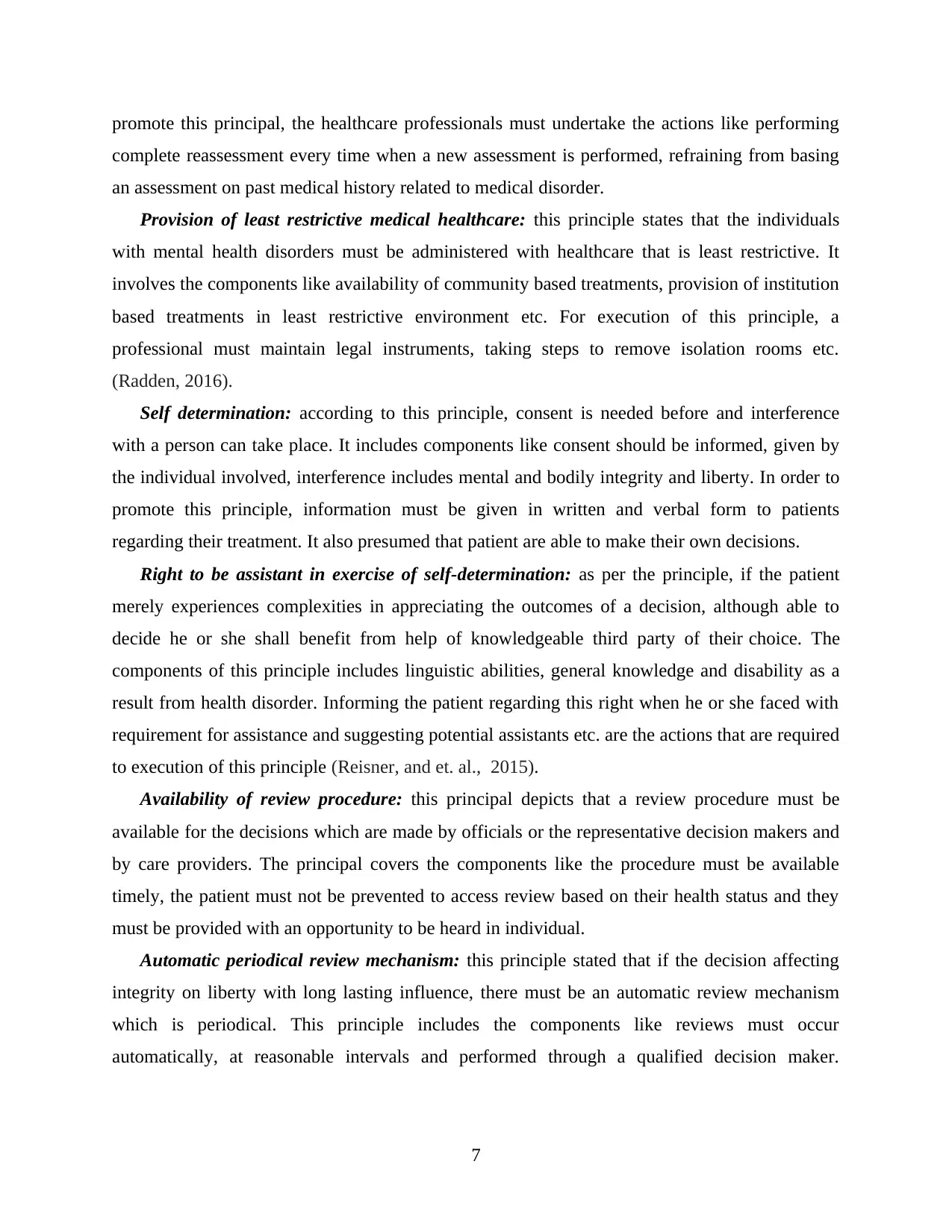
promote this principal, the healthcare professionals must undertake the actions like performing
complete reassessment every time when a new assessment is performed, refraining from basing
an assessment on past medical history related to medical disorder.
Provision of least restrictive medical healthcare: this principle states that the individuals
with mental health disorders must be administered with healthcare that is least restrictive. It
involves the components like availability of community based treatments, provision of institution
based treatments in least restrictive environment etc. For execution of this principle, a
professional must maintain legal instruments, taking steps to remove isolation rooms etc.
(Radden, 2016).
Self determination: according to this principle, consent is needed before and interference
with a person can take place. It includes components like consent should be informed, given by
the individual involved, interference includes mental and bodily integrity and liberty. In order to
promote this principle, information must be given in written and verbal form to patients
regarding their treatment. It also presumed that patient are able to make their own decisions.
Right to be assistant in exercise of self-determination: as per the principle, if the patient
merely experiences complexities in appreciating the outcomes of a decision, although able to
decide he or she shall benefit from help of knowledgeable third party of their choice. The
components of this principle includes linguistic abilities, general knowledge and disability as a
result from health disorder. Informing the patient regarding this right when he or she faced with
requirement for assistance and suggesting potential assistants etc. are the actions that are required
to execution of this principle (Reisner, and et. al., 2015).
Availability of review procedure: this principal depicts that a review procedure must be
available for the decisions which are made by officials or the representative decision makers and
by care providers. The principal covers the components like the procedure must be available
timely, the patient must not be prevented to access review based on their health status and they
must be provided with an opportunity to be heard in individual.
Automatic periodical review mechanism: this principle stated that if the decision affecting
integrity on liberty with long lasting influence, there must be an automatic review mechanism
which is periodical. This principle includes the components like reviews must occur
automatically, at reasonable intervals and performed through a qualified decision maker.
7
complete reassessment every time when a new assessment is performed, refraining from basing
an assessment on past medical history related to medical disorder.
Provision of least restrictive medical healthcare: this principle states that the individuals
with mental health disorders must be administered with healthcare that is least restrictive. It
involves the components like availability of community based treatments, provision of institution
based treatments in least restrictive environment etc. For execution of this principle, a
professional must maintain legal instruments, taking steps to remove isolation rooms etc.
(Radden, 2016).
Self determination: according to this principle, consent is needed before and interference
with a person can take place. It includes components like consent should be informed, given by
the individual involved, interference includes mental and bodily integrity and liberty. In order to
promote this principle, information must be given in written and verbal form to patients
regarding their treatment. It also presumed that patient are able to make their own decisions.
Right to be assistant in exercise of self-determination: as per the principle, if the patient
merely experiences complexities in appreciating the outcomes of a decision, although able to
decide he or she shall benefit from help of knowledgeable third party of their choice. The
components of this principle includes linguistic abilities, general knowledge and disability as a
result from health disorder. Informing the patient regarding this right when he or she faced with
requirement for assistance and suggesting potential assistants etc. are the actions that are required
to execution of this principle (Reisner, and et. al., 2015).
Availability of review procedure: this principal depicts that a review procedure must be
available for the decisions which are made by officials or the representative decision makers and
by care providers. The principal covers the components like the procedure must be available
timely, the patient must not be prevented to access review based on their health status and they
must be provided with an opportunity to be heard in individual.
Automatic periodical review mechanism: this principle stated that if the decision affecting
integrity on liberty with long lasting influence, there must be an automatic review mechanism
which is periodical. This principle includes the components like reviews must occur
automatically, at reasonable intervals and performed through a qualified decision maker.
7
Paraphrase This Document
Need a fresh take? Get an instant paraphrase of this document with our AI Paraphraser
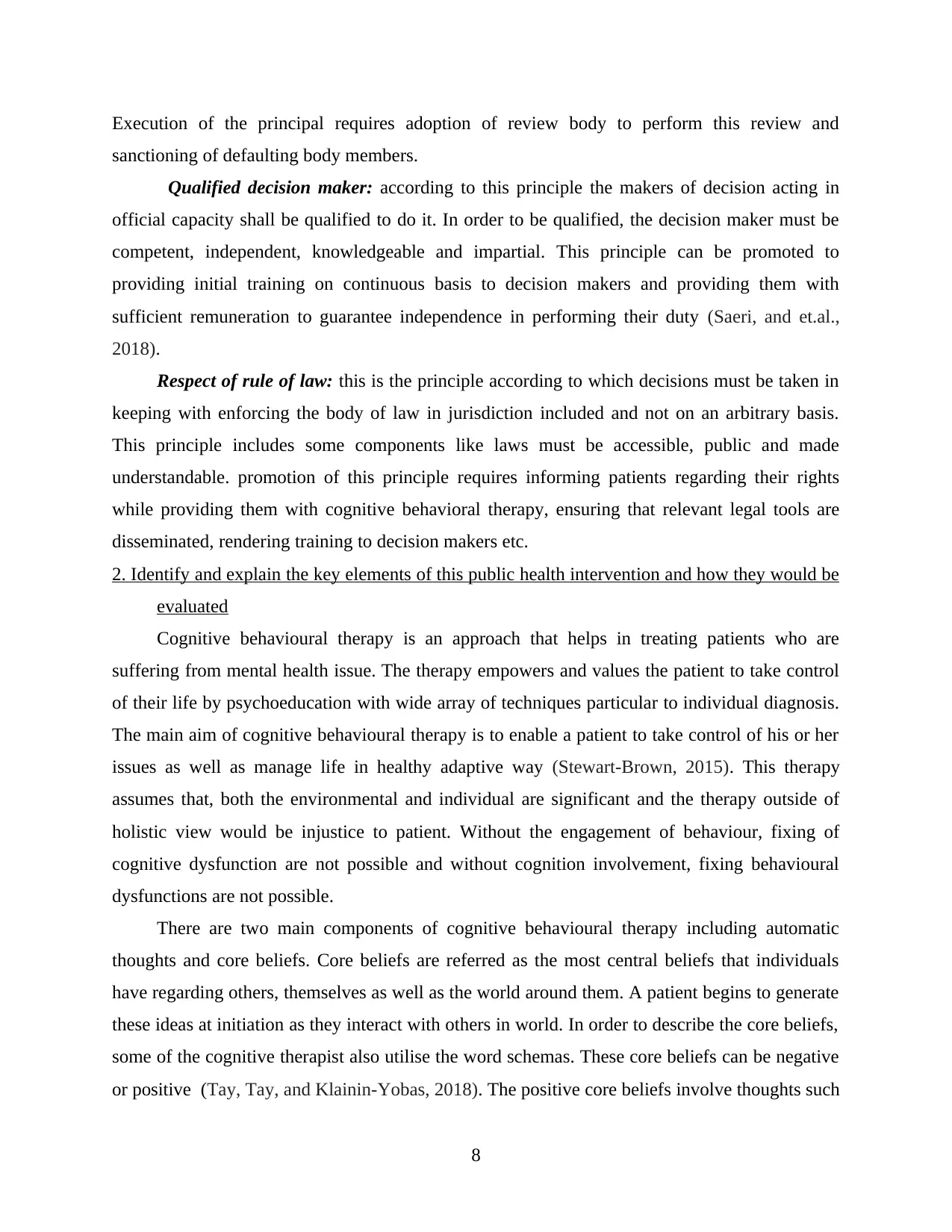
Execution of the principal requires adoption of review body to perform this review and
sanctioning of defaulting body members.
Qualified decision maker: according to this principle the makers of decision acting in
official capacity shall be qualified to do it. In order to be qualified, the decision maker must be
competent, independent, knowledgeable and impartial. This principle can be promoted to
providing initial training on continuous basis to decision makers and providing them with
sufficient remuneration to guarantee independence in performing their duty (Saeri, and et.al.,
2018).
Respect of rule of law: this is the principle according to which decisions must be taken in
keeping with enforcing the body of law in jurisdiction included and not on an arbitrary basis.
This principle includes some components like laws must be accessible, public and made
understandable. promotion of this principle requires informing patients regarding their rights
while providing them with cognitive behavioral therapy, ensuring that relevant legal tools are
disseminated, rendering training to decision makers etc.
2. Identify and explain the key elements of this public health intervention and how they would be
evaluated
Cognitive behavioural therapy is an approach that helps in treating patients who are
suffering from mental health issue. The therapy empowers and values the patient to take control
of their life by psychoeducation with wide array of techniques particular to individual diagnosis.
The main aim of cognitive behavioural therapy is to enable a patient to take control of his or her
issues as well as manage life in healthy adaptive way (Stewart-Brown, 2015). This therapy
assumes that, both the environmental and individual are significant and the therapy outside of
holistic view would be injustice to patient. Without the engagement of behaviour, fixing of
cognitive dysfunction are not possible and without cognition involvement, fixing behavioural
dysfunctions are not possible.
There are two main components of cognitive behavioural therapy including automatic
thoughts and core beliefs. Core beliefs are referred as the most central beliefs that individuals
have regarding others, themselves as well as the world around them. A patient begins to generate
these ideas at initiation as they interact with others in world. In order to describe the core beliefs,
some of the cognitive therapist also utilise the word schemas. These core beliefs can be negative
or positive (Tay, Tay, and Klainin-Yobas, 2018). The positive core beliefs involve thoughts such
8
sanctioning of defaulting body members.
Qualified decision maker: according to this principle the makers of decision acting in
official capacity shall be qualified to do it. In order to be qualified, the decision maker must be
competent, independent, knowledgeable and impartial. This principle can be promoted to
providing initial training on continuous basis to decision makers and providing them with
sufficient remuneration to guarantee independence in performing their duty (Saeri, and et.al.,
2018).
Respect of rule of law: this is the principle according to which decisions must be taken in
keeping with enforcing the body of law in jurisdiction included and not on an arbitrary basis.
This principle includes some components like laws must be accessible, public and made
understandable. promotion of this principle requires informing patients regarding their rights
while providing them with cognitive behavioral therapy, ensuring that relevant legal tools are
disseminated, rendering training to decision makers etc.
2. Identify and explain the key elements of this public health intervention and how they would be
evaluated
Cognitive behavioural therapy is an approach that helps in treating patients who are
suffering from mental health issue. The therapy empowers and values the patient to take control
of their life by psychoeducation with wide array of techniques particular to individual diagnosis.
The main aim of cognitive behavioural therapy is to enable a patient to take control of his or her
issues as well as manage life in healthy adaptive way (Stewart-Brown, 2015). This therapy
assumes that, both the environmental and individual are significant and the therapy outside of
holistic view would be injustice to patient. Without the engagement of behaviour, fixing of
cognitive dysfunction are not possible and without cognition involvement, fixing behavioural
dysfunctions are not possible.
There are two main components of cognitive behavioural therapy including automatic
thoughts and core beliefs. Core beliefs are referred as the most central beliefs that individuals
have regarding others, themselves as well as the world around them. A patient begins to generate
these ideas at initiation as they interact with others in world. In order to describe the core beliefs,
some of the cognitive therapist also utilise the word schemas. These core beliefs can be negative
or positive (Tay, Tay, and Klainin-Yobas, 2018). The positive core beliefs involve thoughts such
8
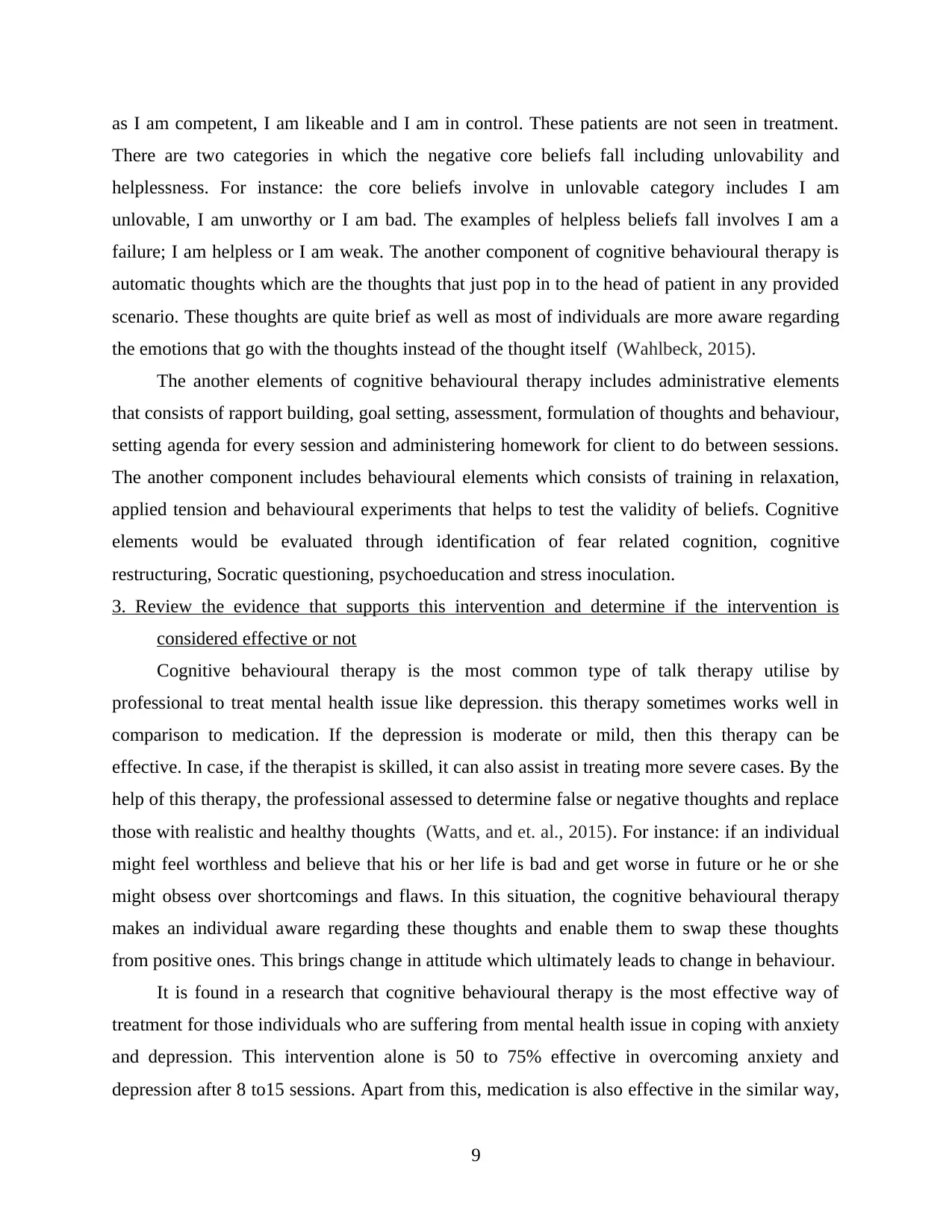
as I am competent, I am likeable and I am in control. These patients are not seen in treatment.
There are two categories in which the negative core beliefs fall including unlovability and
helplessness. For instance: the core beliefs involve in unlovable category includes I am
unlovable, I am unworthy or I am bad. The examples of helpless beliefs fall involves I am a
failure; I am helpless or I am weak. The another component of cognitive behavioural therapy is
automatic thoughts which are the thoughts that just pop in to the head of patient in any provided
scenario. These thoughts are quite brief as well as most of individuals are more aware regarding
the emotions that go with the thoughts instead of the thought itself (Wahlbeck, 2015).
The another elements of cognitive behavioural therapy includes administrative elements
that consists of rapport building, goal setting, assessment, formulation of thoughts and behaviour,
setting agenda for every session and administering homework for client to do between sessions.
The another component includes behavioural elements which consists of training in relaxation,
applied tension and behavioural experiments that helps to test the validity of beliefs. Cognitive
elements would be evaluated through identification of fear related cognition, cognitive
restructuring, Socratic questioning, psychoeducation and stress inoculation.
3. Review the evidence that supports this intervention and determine if the intervention is
considered effective or not
Cognitive behavioural therapy is the most common type of talk therapy utilise by
professional to treat mental health issue like depression. this therapy sometimes works well in
comparison to medication. If the depression is moderate or mild, then this therapy can be
effective. In case, if the therapist is skilled, it can also assist in treating more severe cases. By the
help of this therapy, the professional assessed to determine false or negative thoughts and replace
those with realistic and healthy thoughts (Watts, and et. al., 2015). For instance: if an individual
might feel worthless and believe that his or her life is bad and get worse in future or he or she
might obsess over shortcomings and flaws. In this situation, the cognitive behavioural therapy
makes an individual aware regarding these thoughts and enable them to swap these thoughts
from positive ones. This brings change in attitude which ultimately leads to change in behaviour.
It is found in a research that cognitive behavioural therapy is the most effective way of
treatment for those individuals who are suffering from mental health issue in coping with anxiety
and depression. This intervention alone is 50 to 75% effective in overcoming anxiety and
depression after 8 to15 sessions. Apart from this, medication is also effective in the similar way,
9
There are two categories in which the negative core beliefs fall including unlovability and
helplessness. For instance: the core beliefs involve in unlovable category includes I am
unlovable, I am unworthy or I am bad. The examples of helpless beliefs fall involves I am a
failure; I am helpless or I am weak. The another component of cognitive behavioural therapy is
automatic thoughts which are the thoughts that just pop in to the head of patient in any provided
scenario. These thoughts are quite brief as well as most of individuals are more aware regarding
the emotions that go with the thoughts instead of the thought itself (Wahlbeck, 2015).
The another elements of cognitive behavioural therapy includes administrative elements
that consists of rapport building, goal setting, assessment, formulation of thoughts and behaviour,
setting agenda for every session and administering homework for client to do between sessions.
The another component includes behavioural elements which consists of training in relaxation,
applied tension and behavioural experiments that helps to test the validity of beliefs. Cognitive
elements would be evaluated through identification of fear related cognition, cognitive
restructuring, Socratic questioning, psychoeducation and stress inoculation.
3. Review the evidence that supports this intervention and determine if the intervention is
considered effective or not
Cognitive behavioural therapy is the most common type of talk therapy utilise by
professional to treat mental health issue like depression. this therapy sometimes works well in
comparison to medication. If the depression is moderate or mild, then this therapy can be
effective. In case, if the therapist is skilled, it can also assist in treating more severe cases. By the
help of this therapy, the professional assessed to determine false or negative thoughts and replace
those with realistic and healthy thoughts (Watts, and et. al., 2015). For instance: if an individual
might feel worthless and believe that his or her life is bad and get worse in future or he or she
might obsess over shortcomings and flaws. In this situation, the cognitive behavioural therapy
makes an individual aware regarding these thoughts and enable them to swap these thoughts
from positive ones. This brings change in attitude which ultimately leads to change in behaviour.
It is found in a research that cognitive behavioural therapy is the most effective way of
treatment for those individuals who are suffering from mental health issue in coping with anxiety
and depression. This intervention alone is 50 to 75% effective in overcoming anxiety and
depression after 8 to15 sessions. Apart from this, medication is also effective in the similar way,
9
⊘ This is a preview!⊘
Do you want full access?
Subscribe today to unlock all pages.

Trusted by 1+ million students worldwide
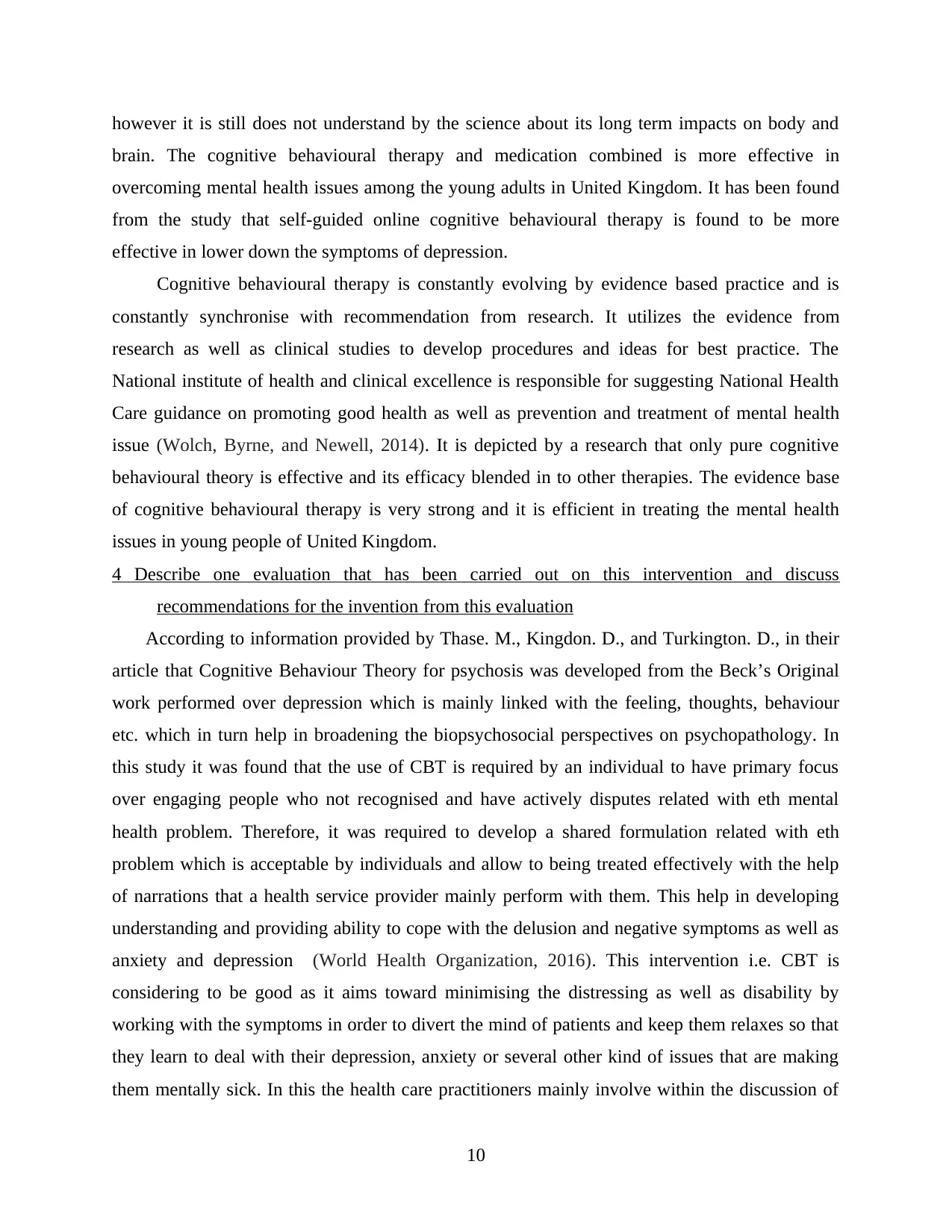
however it is still does not understand by the science about its long term impacts on body and
brain. The cognitive behavioural therapy and medication combined is more effective in
overcoming mental health issues among the young adults in United Kingdom. It has been found
from the study that self-guided online cognitive behavioural therapy is found to be more
effective in lower down the symptoms of depression.
Cognitive behavioural therapy is constantly evolving by evidence based practice and is
constantly synchronise with recommendation from research. It utilizes the evidence from
research as well as clinical studies to develop procedures and ideas for best practice. The
National institute of health and clinical excellence is responsible for suggesting National Health
Care guidance on promoting good health as well as prevention and treatment of mental health
issue (Wolch, Byrne, and Newell, 2014). It is depicted by a research that only pure cognitive
behavioural theory is effective and its efficacy blended in to other therapies. The evidence base
of cognitive behavioural therapy is very strong and it is efficient in treating the mental health
issues in young people of United Kingdom.
4 Describe one evaluation that has been carried out on this intervention and discuss
recommendations for the invention from this evaluation
According to information provided by Thase. M., Kingdon. D., and Turkington. D., in their
article that Cognitive Behaviour Theory for psychosis was developed from the Beck’s Original
work performed over depression which is mainly linked with the feeling, thoughts, behaviour
etc. which in turn help in broadening the biopsychosocial perspectives on psychopathology. In
this study it was found that the use of CBT is required by an individual to have primary focus
over engaging people who not recognised and have actively disputes related with eth mental
health problem. Therefore, it was required to develop a shared formulation related with eth
problem which is acceptable by individuals and allow to being treated effectively with the help
of narrations that a health service provider mainly perform with them. This help in developing
understanding and providing ability to cope with the delusion and negative symptoms as well as
anxiety and depression (World Health Organization, 2016). This intervention i.e. CBT is
considering to be good as it aims toward minimising the distressing as well as disability by
working with the symptoms in order to divert the mind of patients and keep them relaxes so that
they learn to deal with their depression, anxiety or several other kind of issues that are making
them mentally sick. In this the health care practitioners mainly involve within the discussion of
10
brain. The cognitive behavioural therapy and medication combined is more effective in
overcoming mental health issues among the young adults in United Kingdom. It has been found
from the study that self-guided online cognitive behavioural therapy is found to be more
effective in lower down the symptoms of depression.
Cognitive behavioural therapy is constantly evolving by evidence based practice and is
constantly synchronise with recommendation from research. It utilizes the evidence from
research as well as clinical studies to develop procedures and ideas for best practice. The
National institute of health and clinical excellence is responsible for suggesting National Health
Care guidance on promoting good health as well as prevention and treatment of mental health
issue (Wolch, Byrne, and Newell, 2014). It is depicted by a research that only pure cognitive
behavioural theory is effective and its efficacy blended in to other therapies. The evidence base
of cognitive behavioural therapy is very strong and it is efficient in treating the mental health
issues in young people of United Kingdom.
4 Describe one evaluation that has been carried out on this intervention and discuss
recommendations for the invention from this evaluation
According to information provided by Thase. M., Kingdon. D., and Turkington. D., in their
article that Cognitive Behaviour Theory for psychosis was developed from the Beck’s Original
work performed over depression which is mainly linked with the feeling, thoughts, behaviour
etc. which in turn help in broadening the biopsychosocial perspectives on psychopathology. In
this study it was found that the use of CBT is required by an individual to have primary focus
over engaging people who not recognised and have actively disputes related with eth mental
health problem. Therefore, it was required to develop a shared formulation related with eth
problem which is acceptable by individuals and allow to being treated effectively with the help
of narrations that a health service provider mainly perform with them. This help in developing
understanding and providing ability to cope with the delusion and negative symptoms as well as
anxiety and depression (World Health Organization, 2016). This intervention i.e. CBT is
considering to be good as it aims toward minimising the distressing as well as disability by
working with the symptoms in order to divert the mind of patients and keep them relaxes so that
they learn to deal with their depression, anxiety or several other kind of issues that are making
them mentally sick. In this the health care practitioners mainly involve within the discussion of
10
Paraphrase This Document
Need a fresh take? Get an instant paraphrase of this document with our AI Paraphraser
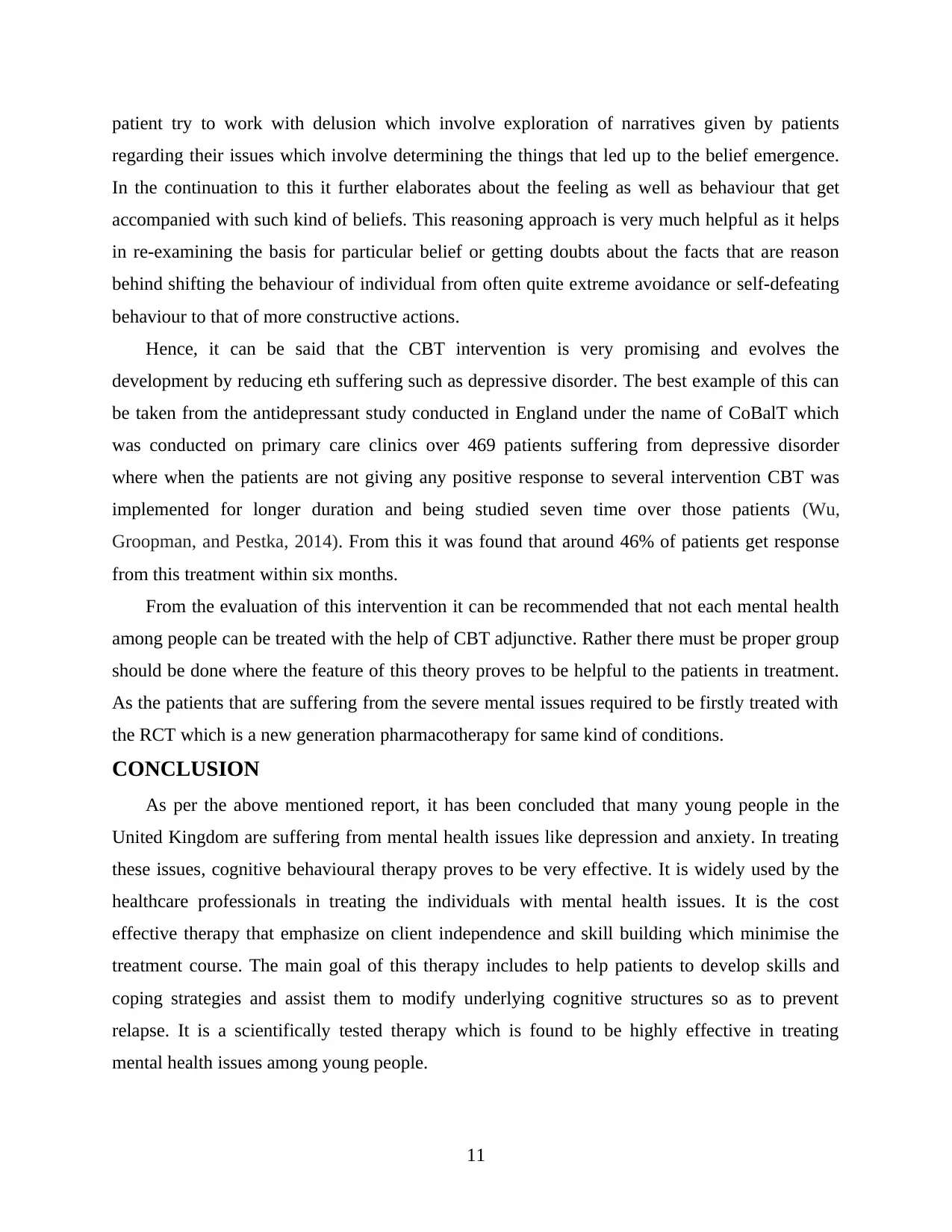
patient try to work with delusion which involve exploration of narratives given by patients
regarding their issues which involve determining the things that led up to the belief emergence.
In the continuation to this it further elaborates about the feeling as well as behaviour that get
accompanied with such kind of beliefs. This reasoning approach is very much helpful as it helps
in re-examining the basis for particular belief or getting doubts about the facts that are reason
behind shifting the behaviour of individual from often quite extreme avoidance or self-defeating
behaviour to that of more constructive actions.
Hence, it can be said that the CBT intervention is very promising and evolves the
development by reducing eth suffering such as depressive disorder. The best example of this can
be taken from the antidepressant study conducted in England under the name of CoBalT which
was conducted on primary care clinics over 469 patients suffering from depressive disorder
where when the patients are not giving any positive response to several intervention CBT was
implemented for longer duration and being studied seven time over those patients (Wu,
Groopman, and Pestka, 2014). From this it was found that around 46% of patients get response
from this treatment within six months.
From the evaluation of this intervention it can be recommended that not each mental health
among people can be treated with the help of CBT adjunctive. Rather there must be proper group
should be done where the feature of this theory proves to be helpful to the patients in treatment.
As the patients that are suffering from the severe mental issues required to be firstly treated with
the RCT which is a new generation pharmacotherapy for same kind of conditions.
CONCLUSION
As per the above mentioned report, it has been concluded that many young people in the
United Kingdom are suffering from mental health issues like depression and anxiety. In treating
these issues, cognitive behavioural therapy proves to be very effective. It is widely used by the
healthcare professionals in treating the individuals with mental health issues. It is the cost
effective therapy that emphasize on client independence and skill building which minimise the
treatment course. The main goal of this therapy includes to help patients to develop skills and
coping strategies and assist them to modify underlying cognitive structures so as to prevent
relapse. It is a scientifically tested therapy which is found to be highly effective in treating
mental health issues among young people.
11
regarding their issues which involve determining the things that led up to the belief emergence.
In the continuation to this it further elaborates about the feeling as well as behaviour that get
accompanied with such kind of beliefs. This reasoning approach is very much helpful as it helps
in re-examining the basis for particular belief or getting doubts about the facts that are reason
behind shifting the behaviour of individual from often quite extreme avoidance or self-defeating
behaviour to that of more constructive actions.
Hence, it can be said that the CBT intervention is very promising and evolves the
development by reducing eth suffering such as depressive disorder. The best example of this can
be taken from the antidepressant study conducted in England under the name of CoBalT which
was conducted on primary care clinics over 469 patients suffering from depressive disorder
where when the patients are not giving any positive response to several intervention CBT was
implemented for longer duration and being studied seven time over those patients (Wu,
Groopman, and Pestka, 2014). From this it was found that around 46% of patients get response
from this treatment within six months.
From the evaluation of this intervention it can be recommended that not each mental health
among people can be treated with the help of CBT adjunctive. Rather there must be proper group
should be done where the feature of this theory proves to be helpful to the patients in treatment.
As the patients that are suffering from the severe mental issues required to be firstly treated with
the RCT which is a new generation pharmacotherapy for same kind of conditions.
CONCLUSION
As per the above mentioned report, it has been concluded that many young people in the
United Kingdom are suffering from mental health issues like depression and anxiety. In treating
these issues, cognitive behavioural therapy proves to be very effective. It is widely used by the
healthcare professionals in treating the individuals with mental health issues. It is the cost
effective therapy that emphasize on client independence and skill building which minimise the
treatment course. The main goal of this therapy includes to help patients to develop skills and
coping strategies and assist them to modify underlying cognitive structures so as to prevent
relapse. It is a scientifically tested therapy which is found to be highly effective in treating
mental health issues among young people.
11
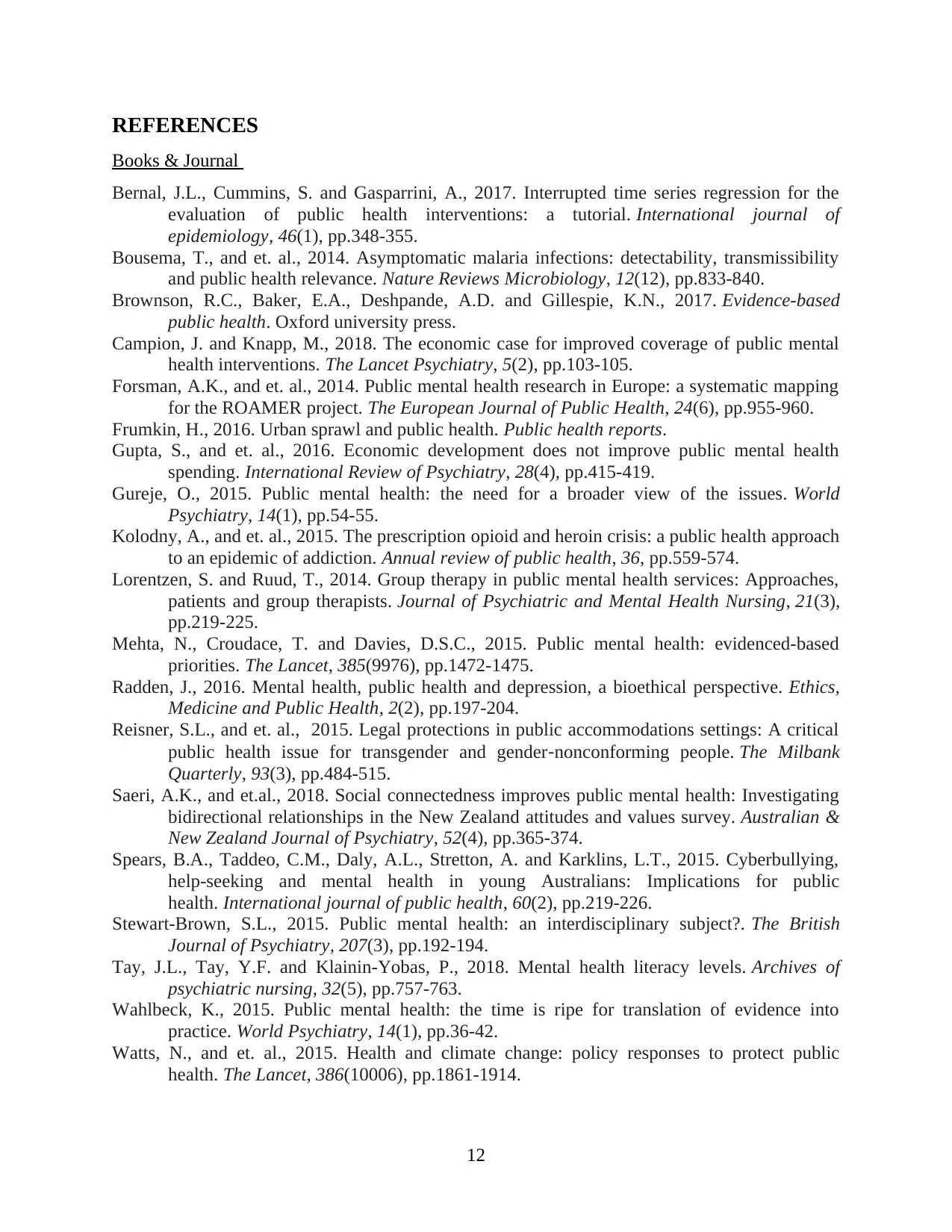
REFERENCES
Books & Journal
Bernal, J.L., Cummins, S. and Gasparrini, A., 2017. Interrupted time series regression for the
evaluation of public health interventions: a tutorial. International journal of
epidemiology, 46(1), pp.348-355.
Bousema, T., and et. al., 2014. Asymptomatic malaria infections: detectability, transmissibility
and public health relevance. Nature Reviews Microbiology, 12(12), pp.833-840.
Brownson, R.C., Baker, E.A., Deshpande, A.D. and Gillespie, K.N., 2017. Evidence-based
public health. Oxford university press.
Campion, J. and Knapp, M., 2018. The economic case for improved coverage of public mental
health interventions. The Lancet Psychiatry, 5(2), pp.103-105.
Forsman, A.K., and et. al., 2014. Public mental health research in Europe: a systematic mapping
for the ROAMER project. The European Journal of Public Health, 24(6), pp.955-960.
Frumkin, H., 2016. Urban sprawl and public health. Public health reports.
Gupta, S., and et. al., 2016. Economic development does not improve public mental health
spending. International Review of Psychiatry, 28(4), pp.415-419.
Gureje, O., 2015. Public mental health: the need for a broader view of the issues. World
Psychiatry, 14(1), pp.54-55.
Kolodny, A., and et. al., 2015. The prescription opioid and heroin crisis: a public health approach
to an epidemic of addiction. Annual review of public health, 36, pp.559-574.
Lorentzen, S. and Ruud, T., 2014. Group therapy in public mental health services: Approaches,
patients and group therapists. Journal of Psychiatric and Mental Health Nursing, 21(3),
pp.219-225.
Mehta, N., Croudace, T. and Davies, D.S.C., 2015. Public mental health: evidenced-based
priorities. The Lancet, 385(9976), pp.1472-1475.
Radden, J., 2016. Mental health, public health and depression, a bioethical perspective. Ethics,
Medicine and Public Health, 2(2), pp.197-204.
Reisner, S.L., and et. al., 2015. Legal protections in public accommodations settings: A critical
public health issue for transgender and gender‐nonconforming people. The Milbank
Quarterly, 93(3), pp.484-515.
Saeri, A.K., and et.al., 2018. Social connectedness improves public mental health: Investigating
bidirectional relationships in the New Zealand attitudes and values survey. Australian &
New Zealand Journal of Psychiatry, 52(4), pp.365-374.
Spears, B.A., Taddeo, C.M., Daly, A.L., Stretton, A. and Karklins, L.T., 2015. Cyberbullying,
help-seeking and mental health in young Australians: Implications for public
health. International journal of public health, 60(2), pp.219-226.
Stewart-Brown, S.L., 2015. Public mental health: an interdisciplinary subject?. The British
Journal of Psychiatry, 207(3), pp.192-194.
Tay, J.L., Tay, Y.F. and Klainin-Yobas, P., 2018. Mental health literacy levels. Archives of
psychiatric nursing, 32(5), pp.757-763.
Wahlbeck, K., 2015. Public mental health: the time is ripe for translation of evidence into
practice. World Psychiatry, 14(1), pp.36-42.
Watts, N., and et. al., 2015. Health and climate change: policy responses to protect public
health. The Lancet, 386(10006), pp.1861-1914.
12
Books & Journal
Bernal, J.L., Cummins, S. and Gasparrini, A., 2017. Interrupted time series regression for the
evaluation of public health interventions: a tutorial. International journal of
epidemiology, 46(1), pp.348-355.
Bousema, T., and et. al., 2014. Asymptomatic malaria infections: detectability, transmissibility
and public health relevance. Nature Reviews Microbiology, 12(12), pp.833-840.
Brownson, R.C., Baker, E.A., Deshpande, A.D. and Gillespie, K.N., 2017. Evidence-based
public health. Oxford university press.
Campion, J. and Knapp, M., 2018. The economic case for improved coverage of public mental
health interventions. The Lancet Psychiatry, 5(2), pp.103-105.
Forsman, A.K., and et. al., 2014. Public mental health research in Europe: a systematic mapping
for the ROAMER project. The European Journal of Public Health, 24(6), pp.955-960.
Frumkin, H., 2016. Urban sprawl and public health. Public health reports.
Gupta, S., and et. al., 2016. Economic development does not improve public mental health
spending. International Review of Psychiatry, 28(4), pp.415-419.
Gureje, O., 2015. Public mental health: the need for a broader view of the issues. World
Psychiatry, 14(1), pp.54-55.
Kolodny, A., and et. al., 2015. The prescription opioid and heroin crisis: a public health approach
to an epidemic of addiction. Annual review of public health, 36, pp.559-574.
Lorentzen, S. and Ruud, T., 2014. Group therapy in public mental health services: Approaches,
patients and group therapists. Journal of Psychiatric and Mental Health Nursing, 21(3),
pp.219-225.
Mehta, N., Croudace, T. and Davies, D.S.C., 2015. Public mental health: evidenced-based
priorities. The Lancet, 385(9976), pp.1472-1475.
Radden, J., 2016. Mental health, public health and depression, a bioethical perspective. Ethics,
Medicine and Public Health, 2(2), pp.197-204.
Reisner, S.L., and et. al., 2015. Legal protections in public accommodations settings: A critical
public health issue for transgender and gender‐nonconforming people. The Milbank
Quarterly, 93(3), pp.484-515.
Saeri, A.K., and et.al., 2018. Social connectedness improves public mental health: Investigating
bidirectional relationships in the New Zealand attitudes and values survey. Australian &
New Zealand Journal of Psychiatry, 52(4), pp.365-374.
Spears, B.A., Taddeo, C.M., Daly, A.L., Stretton, A. and Karklins, L.T., 2015. Cyberbullying,
help-seeking and mental health in young Australians: Implications for public
health. International journal of public health, 60(2), pp.219-226.
Stewart-Brown, S.L., 2015. Public mental health: an interdisciplinary subject?. The British
Journal of Psychiatry, 207(3), pp.192-194.
Tay, J.L., Tay, Y.F. and Klainin-Yobas, P., 2018. Mental health literacy levels. Archives of
psychiatric nursing, 32(5), pp.757-763.
Wahlbeck, K., 2015. Public mental health: the time is ripe for translation of evidence into
practice. World Psychiatry, 14(1), pp.36-42.
Watts, N., and et. al., 2015. Health and climate change: policy responses to protect public
health. The Lancet, 386(10006), pp.1861-1914.
12
⊘ This is a preview!⊘
Do you want full access?
Subscribe today to unlock all pages.

Trusted by 1+ million students worldwide
1 out of 13
Related Documents
Your All-in-One AI-Powered Toolkit for Academic Success.
+13062052269
info@desklib.com
Available 24*7 on WhatsApp / Email
![[object Object]](/_next/static/media/star-bottom.7253800d.svg)
Unlock your academic potential
Copyright © 2020–2025 A2Z Services. All Rights Reserved. Developed and managed by ZUCOL.





